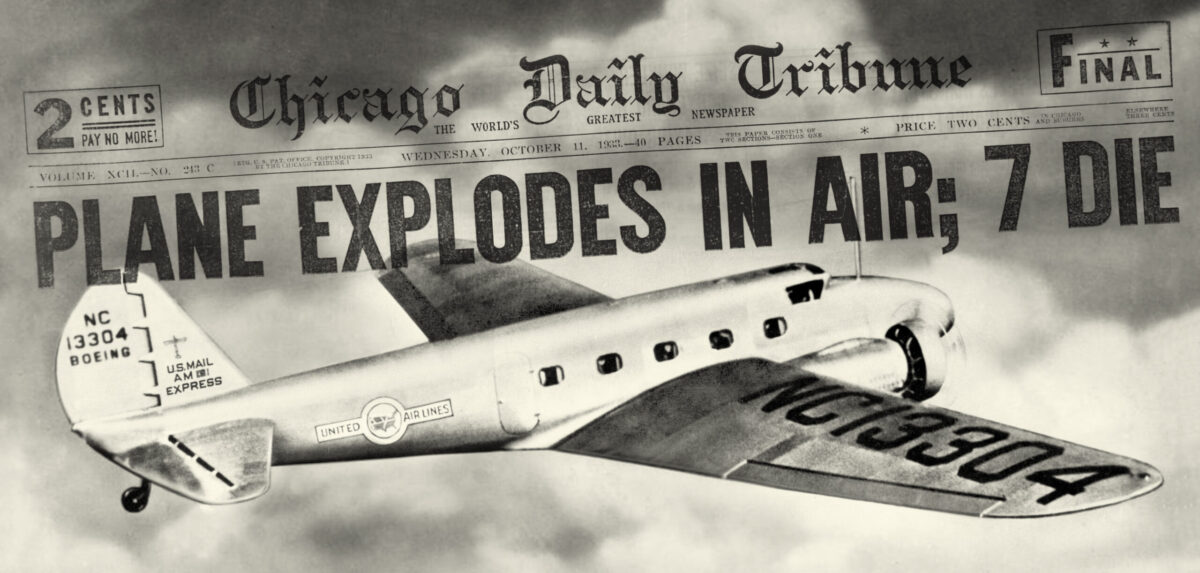At 2:10 p.m. on October 10, 1933, Emil Smith sent a telegram to the aunt with whom he lived in Chicago. “Leaving New York today by plane,” it read. “Everything O.K.” Approximately two hours later, Smith boarded United Air Lines Trip 23 in Newark, New Jersey. The twin-engine Boeing 247, tail number 13304, was headed to Cleveland, where it would refuel and take on a new crew of pilots. Then it was on to Chicago, and from there to the airplane’s final destination of Oakland. Smith had a ticket for Chicago and he carried a small package, wrapped in brown paper, that he kept close to him over the next few hours—the final hours of his life.
Smith and his fellow passengers never made it to Chicago. Just before 9:00 p.m., United Air Lines Trip 23 exploded over Chesterton, Indiana, as it approached Chicago’s Municipal Airport, killing all seven people aboard. Considered the first time a bomb had destroyed a commercial airline flight, the crash became the subject of an intense investigation by the U.S. Bureau of Investigation (the forerunner to the FBI). Overseen by director J. Edgar Hoover and led by Special Agent Melvin Purvis (who would later gain fame leading the manhunts for gangsters George “Baby Face” Nelson, Charles Arthur “Pretty Boy” Floyd and John Dillinger), agents interviewed hundreds of people from Newark and New York to San Francisco. The interviewees even included a young, up-and-coming attorney who would twice win the Democratic Party’s nomination for president two decades later.
Theories for the crash included tail flutter, a meteor strike, a faulty fuel line and sabotage by a disgruntled United pilot upset about the contentious negotiations between the pilots and the airline for increased pay. Those theories fell by the wayside once forensic analysis of the wreckage determined the real cause of the crash: a “high explosive” bomb had exploded near the rear of the airplane, ripping the Boeing in half. Emil Smith soon emerged as the prime suspect. What was in the package he clung to so tightly? Why was he in New York?
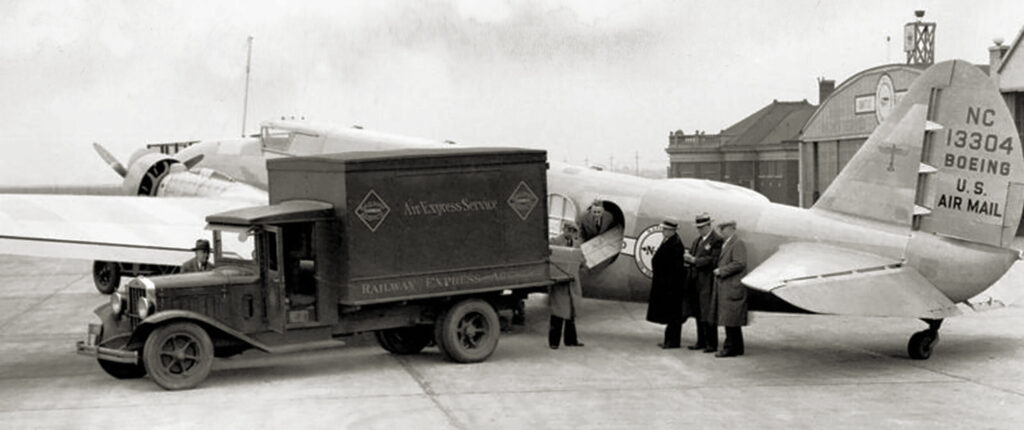
As time passed and every lead led to a dead end, Hoover grew increasingly frustrated. His agents eventually compiled a report that exceeded 300 pages (and was declassified by the FBI in 2017). No arrests were ever made and, 90 years later, the bombing of United Air Lines Trip 23 remains one of aviation’s great unsolved mysteries.
Joe Groff said he was “dealing in a game of hearts with some neighboring farmers shortly before 9 o’clock last night when we heard an explosion,” according to United Press story from October 11, 1933. Groff ran to a window and “saw a big airplane coming down. Flames appeared to be shooting out from it.”
Groff and the other card-playing farmers ran toward the Boeing 247. The wreckage was engulfed in flames that leaped 100 feet high into the night sky. “We stood there in the rain and watched, helpless,” Groff said. “There was nothing we could do. There was no sign of life about the plane.” The airplane continued to burn for more than two hours.
Fred Rhode had a farm nearby. He too ran toward the crash site “but you couldn’t get near the wreckage, the heat was so bad,” he told the Times newspaper of Hammond, Indiana. Hundreds of pieces of the fuselage were scattered across a field and, according to the Times, “one of the charred victims, a woman, was decapitated. Arms and legs, now only burned stumps, added a gruesome touch to the tragedy.”
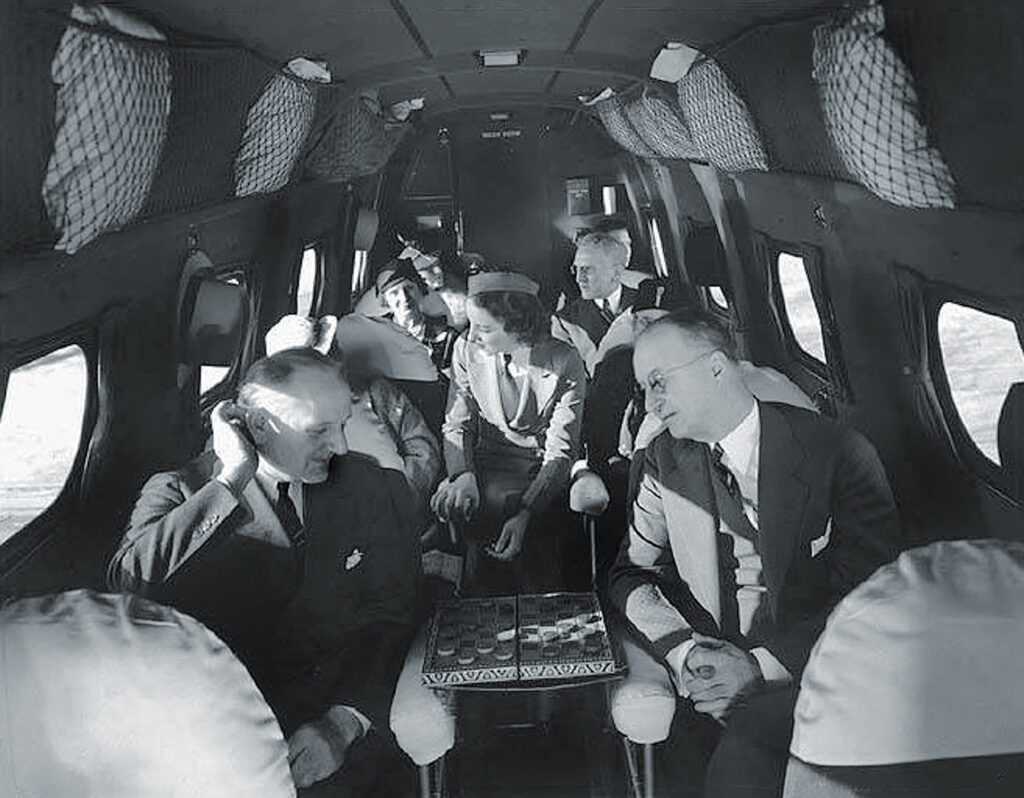
The initial explosion split the airplane in two and “the tail section of the plane fell about one-half mile from the scene of the crash, almost intact,” according to United Air Lines Vice President D.B. Colyer. He said the plane was traveling at about 150 miles per hour when it hit the ground, igniting the remaining gasoline in the airplane’s tanks. “He believes that the impact burst the gasoline tanks and the heat from the fire caused the air in the tires of the wheels to explode,” agents reported. (Colyer theorized that “gasoline escaping from the feed lines may have flowed along the metal body of the plane to the rear section, where it attained a mixture of air and was explosed [sic] by ignition or friction.”)
The bodies of pilot Richard Tarrant and copilot A.T. Ruby were found near the airplane’s main section. The bodies of stewardess Alice Scribner and passengers Dorothy Dwyer and Fred Schendorf were badly burned and found in the wreckage of the cabin.
Dwyer had been scheduled to take an earlier flight from Newark, with a final destination in Reno, Nevada, where she had planned to marry Stanley Baldwin. However, Dwyer missed her connecting flight from Boston and “for this reason she was on the plane that left at 4:30 p.m.,” according to the Bureau of Investigation report. Scribner, a nurse (a qualification to be a stewardess at the time) had recently been hired by United. Her fiancé, Evan Terp, was waiting for her at the airport in Chicago. Schendorf was a businessman from Chicago.
The bodies of Smith and Warren Burris weren’t found until daybreak the following morning, in the weeds about half a mile from the main section of the plane. They had either been blown out of the plane after the explosion or had jumped. Burris was a United employee who was being shuttled from Cleveland to Chicago.
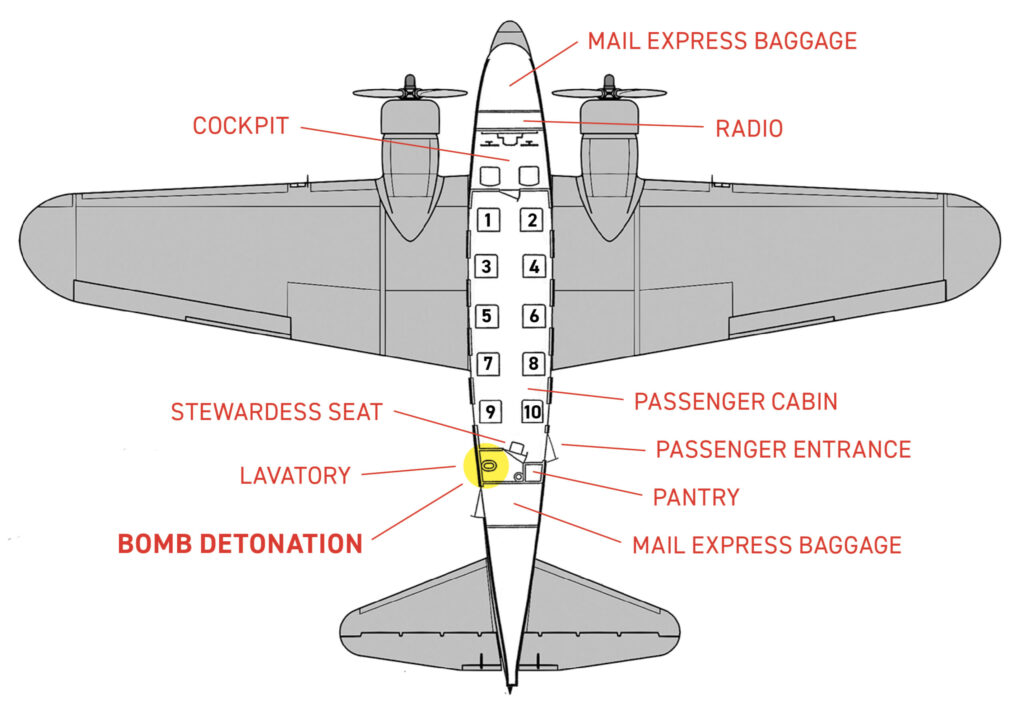
People came from miles around to view the crash, and several picked up pieces of the airplane or its contents as souvenirs. “Mr. Purvis further advised that the Agents are trying to collect parts of the plane picked up by souvenir hunters,” Hoover wrote on October 13.
A day after the crash, United issued a statement reported in the New York Post: “The accident marked the first passenger fatality in a multi-motored plane in the United Air Lines’ experience. The company has flown approximately 40,000,000 miles with multi-motored planes, without previous passenger fatalities. We are strongly of the opinion that the plane did not explode in the air….”
Inspectors with the Aeronautic Branch of the U.S. Department of Commerce told agents a phenomenon called “tail flutter” could have been responsible for the airplane splitting in two. They described it as a vibration of the tail that eventually “wears down the resistance of the body until finally at the time of some strain these parts disintegrate.” There was a precedent for the flutter theory. Back on March 31, 1931, a Transcontinental and Western Air Fokker F-10 had crashed near Bazaar, Kansas, killing all eight people aboard, including legendary Notre Dame football coach Knute Rockne. Investigators were able to determine that a spar in the plane’s all-wooden wings had broken. This created uncontrolled flutter in the wing, which caused one of the wings to tear away from the body of the aircraft.
Forensic science was still in its early stages in 1933 and the Bureau of Investigation did not have its own agents trained in this emerging field. It brought in investigators from the Crime Detection Laboratory at Northwestern University in Chicago to examine the wreckage. In a letter dated October 14, the laboratory’s Dr. C.W. Muehlberger wrote, in his initial report to Purvis, that the cause of the crash was an explosion produced by “a ‘high explosive’ of the type of nitroglycerin, dynamite of high percentage strength, TNT, or some similar substance.” He said the explosion occurred toward the airplane’s rear, in the upper portion of the lavatory or in the blanket compartment built into an upper section of the bathroom compartment. The opening to the blanket compartment was in the rear of main cabin.
Now that agents knew the cause of the explosion, they began to focus on finding out who placed it aboard the plane, their motive and how the bomb was detonated. The answers to these questions proved elusive.
Smith and his package immediately aroused suspicions. He had been in New York in the days before the crash, ensconced at the Roosevelt Hotel on 45th Street and Madison Avenue. Family members in Chicago reported he was in New York to watch the World Series. The Giants had beaten the Washington Senators in five games, with the series-clinching game on October 7 taking place at Griffith Stadium in Washington. There was no evidence Smith attended either of the games played at the Polo Grounds in New York on October 3 and 4, nor was a definitive timeline established on when he arrived in the city and what he did there.
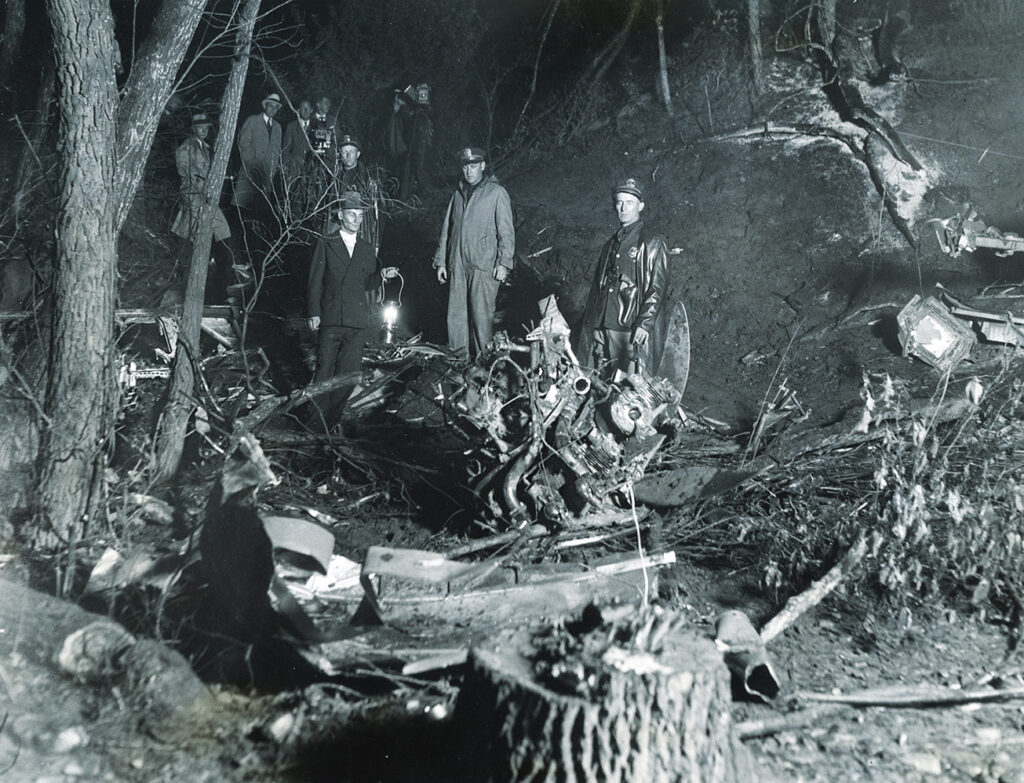
Baggage handlers placed his luggage in the forward baggage compartment and Smith carried his package onto the plane. When the plane stopped to refuel in Cleveland, he initially didn’t want to leave his seat. A passenger agent “instructed Miss Scribner to inform Smith that he should leave the plane while it refueled” and also reported that Smith removed the package from the “parcel holder over his head” and carried it with him as he walked through the Cleveland airport. Informed that Smith had attempted to carry a bottle of liquor aboard the flight in Newark, the passenger agent tried to determine if he was drunk. “Smith seemed entirely sober and normal and no liquor could be smelled on his breath or about his person,” the agent reported.
Agents explored every aspect of Smith’s seemingly ordinary life. An Army veteran who been stationed in Hawaii during World War I, Smith, 44, lived with his aunt, Anna Reidl, on Argyle Street in Chicago. He was a bachelor and had owned and operated a grocery business with Reidl until they sold it in 1930. Smith was “comfortably situated” after the sale and spent his time hunting, fishing and attending baseball games. Reidl told agents Smith lived with her because “his people” didn’t approve of his idle ways and wanted him to find a job. Reidl described her nephew as “very quiet” and said he would “often come in the evenings and play pinochle with her, or would take her on hunting trips with him.”
According to United employees interviewed by agents, Smith took a pint bottle of liquor out of his bag at the Newark airport. He was about to take a drink when a porter advised him it was not allowed. “Smith reluctantly replaced the bottle in the handbag,” the porter said. Then Smith went to the bathroom, leaving his bag on a chair in the waiting room. When he returned from the bathroom, Smith “opened the bag and extracted therefrom a package wrapped in brown paper, which he stated…he would carry.” The package was “about the ordinary length of a shoe.”
Prohibition was still in effect, and Purvis received a tip that Smith had been in New York in connection with a “rum boat” and had been heard to say that if “this deal went through he would be fixed for life.” However, no evidence was ever found connecting Smith with bootleggers in New York.
On October 9, Smith bought a $47.95 ticket for the flights from Newark to Cleveland and on to Chicago at the ticket desk in his hotel. He also purchased a flight insurance policy for $2. It was good for the day only and would have paid $10,000 to Smith’s estate.
Robert Dawson was the United pilot who flew the plane from Newark to Cleveland. He told agents that about 30 minutes before landing, he had walked back into the cabin and talked to Smith, who was sitting in Seat No. 3. “He asked Smith how he was enjoying the trip and Smith replied that he was enjoying it very much.”
United’s D.B. Colyer revised his opinion and said that an explosion in the air had indeed caused the crash and he pointed the finger at Smith. He told agents that “Smith may have been carrying some explosive in the form of nitro-glycerine.”
Eventually the investigation concluded that Smith “was a reputable citizen.” They could not establish a motive or find evidence that he had carried a bomb onto the airplane.
Agents across the country explored every possible lead and theory.
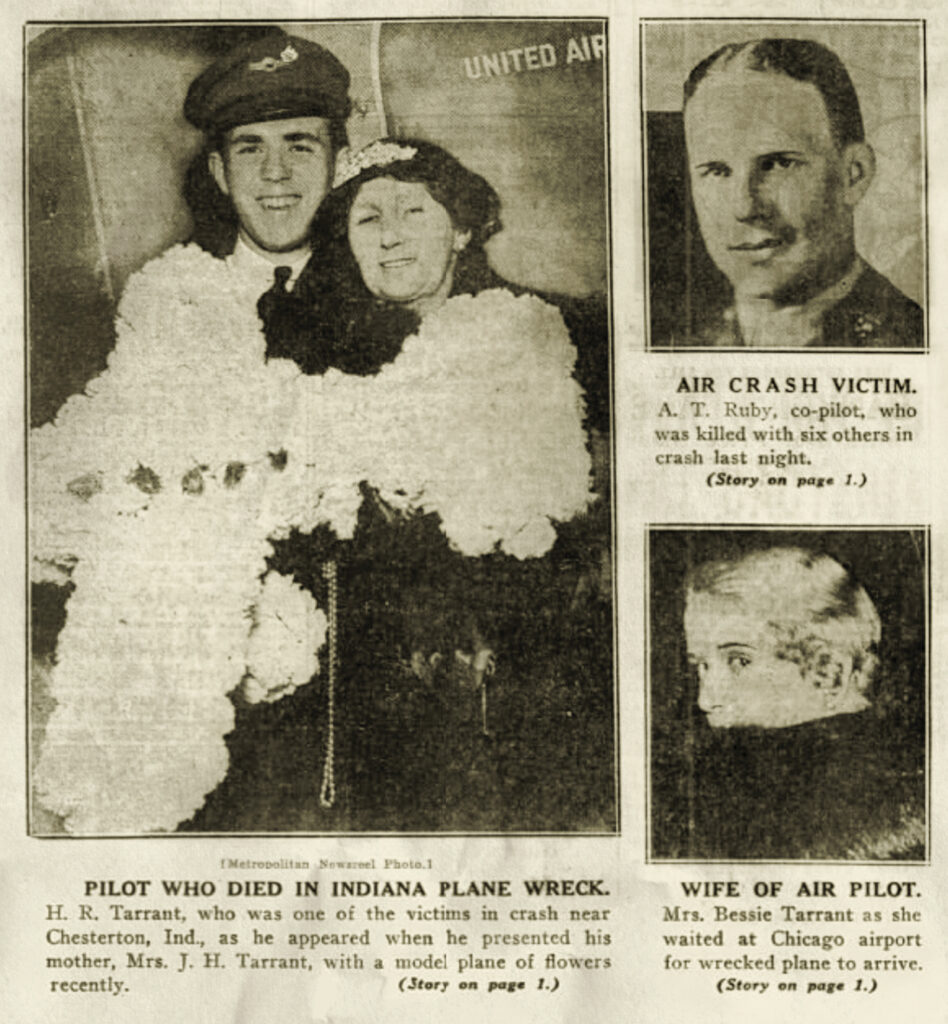
A United Press reporter called an agent and said he’d received information the crash was an attempt to “get” Joseph Keenan, an assistant attorney general with the U.S. Department of Justice who was investigating organized crime. Keenan had flown with United a few days before the crash. “I did not see how this rumor could have any truth,” the agent wrote.
On November 3, 1933, the Chicago Daily Tribune ran a story titled “Hunt Gangster for Murder of Seven in Plane.” The article claimed that agents of the Department of Justice “expect soon to arrest a gangster and charge him,” although “the identity of the gangster was not disclosed.” Purvis reported to Hoover that the story was “made up by the newspaper.”
Several agents investigated the possibility that a disgruntled pilot was responsible. A United vice president said he had been informed indirectly that if the airline used “scab” pilots during the dispute “they would find their planes would be damaged.” The brother of copilot A.T. Ruby told agents his brother “had been having a great deal of trouble with certain individuals who were members of the Pilot’s Union.” Agents in the Detroit office of the Bureau of Investigation interviewed Wharton Larned, the United pilot who had allegedly threatened Ruby. Larned “answered all questions frankly and apparently honestly,” agents reported, and he was ruled out as a suspect. Agents also determined that by the time of the crash “all talk of a strike had blown over and there was no indication of dissatisfaction of any employees or pilots….” No evidence of sabotage by a United employee was found. Another dead end.
The Bureau’s Chicago office even received a letter from an employee of an Argentinian importing and exporting company based in Cleveland suggesting that a meteor had struck the airplane. The letter said that meteors “travelling in the upper space at velocities approaching 30 miles per second in reaching the atmosphere are heated by friction to about 3500 degrees C.…” The Bureau ruled out meteors.
Several passengers on United flights in the days preceding the crash of the Trip 23 flight were interviewed to determine if they had observed any suspicious activities. One of these passengers was Adlai Stevenson, then the chief attorney with the Federal Alcohol Control Administration. He had flown from Washington, D.C., to Cleveland and then Chicago on October 8. “Mr. Stevenson stated that he did not notice anything out of the ordinary on his trip…and that the plane carried eight or ten passengers, besides the two pilots and the hostess.” Decades later, Stevenson would run as the Democratic candidate for president, losing both times to Dwight D. Eisenhower.
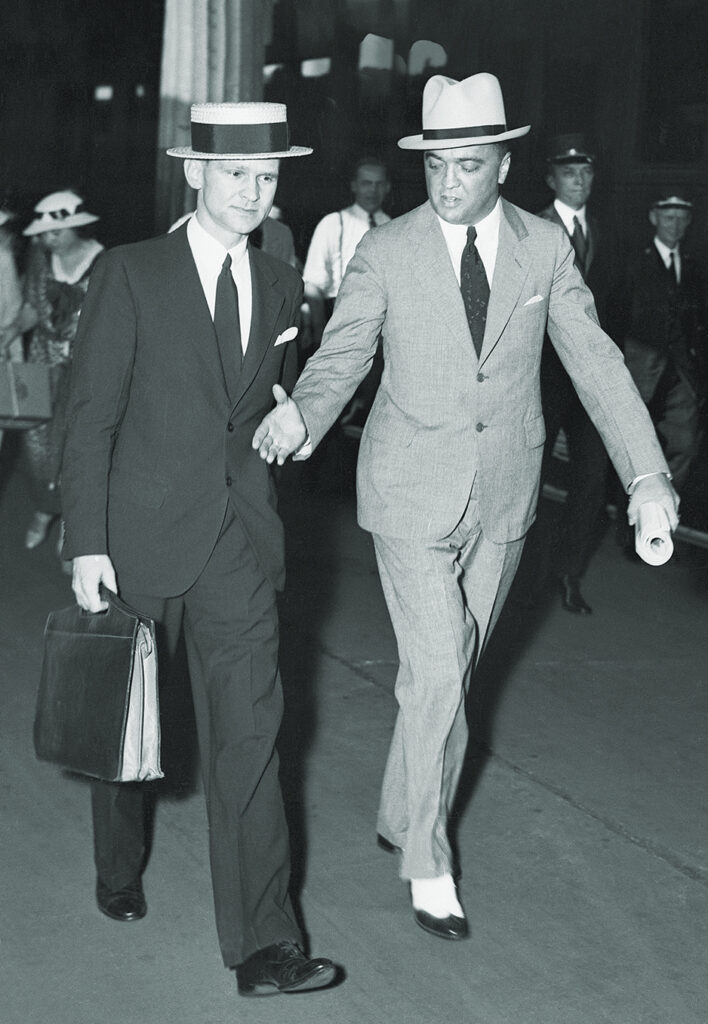
The investigation continued into 1934. Lead after lead went nowhere. “I think that this investigation should continue and the facts be presented to the proper U.S. Attorney,” assistant attorney general Keenan wrote on January 17 in a memorandum to Hoover. By the end of the year the investigation appeared hopelessly stalled. On December 12, Purvis wrote to Hoover that “further interviews with other passengers will reveal no new additional information beneficial to the investigation, and authority is requested, therefore, to close this case in the files of the Chicago office.”
Hoover wrote back, telling Purvis he “desires that a careful review of the file in this case be made and leads set out, with the view of developing further facts pertinent to this investigation.” Hoover sent similar letters to agents in other offices.
Agents in the San Francisco office interviewed J.J. Lavin, an American working for the Chinese Consul in San Francisco who helped oversee the delivery to China of wheat purchased in the United States. He had been scheduled to fly on the ill-fated flight but rescheduled to a later one. Lavin had been overheard saying a bomb caused the crash, supposedly before this information had been reported in newspapers. Lavin told the agents that “he does not recall discussing the matter with anyone, although [he] admitted while under the influence of liquor he may possibly have discussed the matter with various people.”
The investigation continued well into 1935 without any breakthroughs.
On September 20, 1935, Hoover sent a memorandum to Keenan. All “undeveloped leads in this case have been exhausted, and the investigation has not developed any facts which would justify presenting this matter to the United States Attorney. Therefore, this case is being closed.” The crash of United Air Lines Trip 23 remains unsolved.

